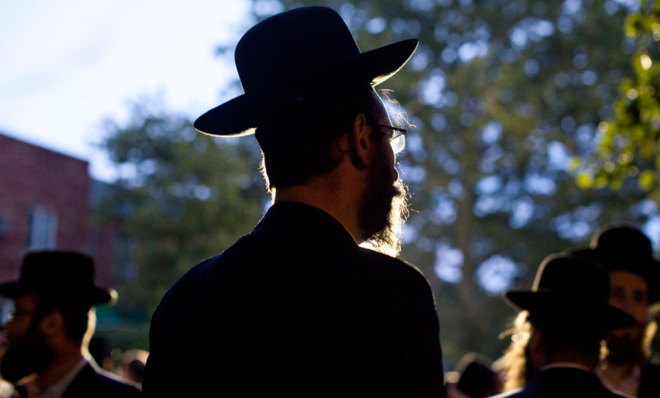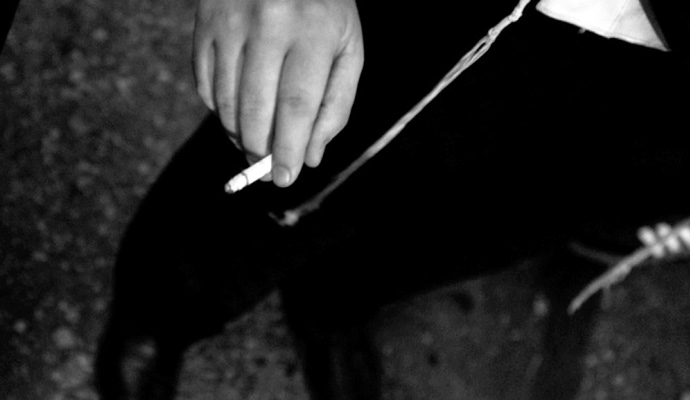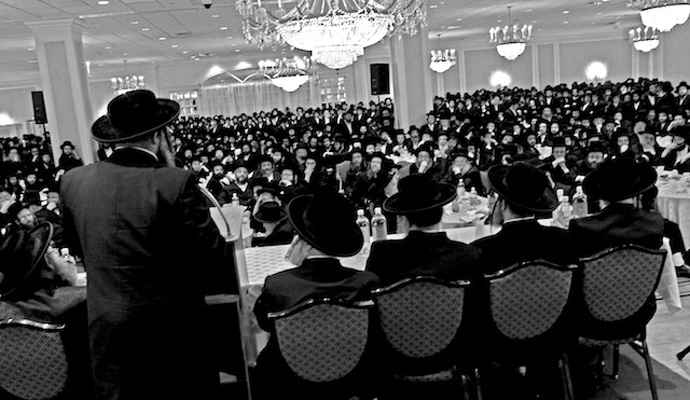The secret life of an Orthodox Jew
There is rarely redemption for a rebellious Hasidic Jew


In a small apartment filled with his children, under the watchful eyes of a tightly knit Hasidic neighborhood in Williamsburg, Brooklyn, a young father says goodbye to his wife. He tells her that he will be seeing relatives across the borough, although he has no intention of going there.
The man's peyos, or side curls, fall to his jaw below a round fur hat, called a shtreimel. His black satin jacket and white shirt — no tie — hang over a fringed prayer shawl. He is handsome, in his twenties, pale, thin and childlike, with just a hint of facial hair. I will call him Joseph; because of the consequences, his real name cannot be revealed here.
Joseph is outside, walking a familiar route, his hands thrust in his pockets and a mysterious smile playing at his lips. He walks past the kosher grocery stores on Lee and Division Streets and reaches Broadway. He examines the passing buildings with the eyes of a man who works in real estate — which he does. He crosses into Williamsburg's other world, where Dominican and hipster cultures collide. Sometimes people stare at this young Hasid wandering at night, but he doesn't seem to mind. He freely gives passing girls a once over, looking back as they walk past him. "I can walk for miles," Joseph tells me, in his thick Yiddish accent. "Walking is my thing. I'm on the phone. I'm thinking. I'm looking. I like to walk alone."
The Week
Escape your echo chamber. Get the facts behind the news, plus analysis from multiple perspectives.

Sign up for The Week's Free Newsletters
From our morning news briefing to a weekly Good News Newsletter, get the best of The Week delivered directly to your inbox.
From our morning news briefing to a weekly Good News Newsletter, get the best of The Week delivered directly to your inbox.
A few weeks earlier, on one of his evening strolls, I had run into Joseph on the Williamsburg waterfront, watching the Manhattan skyline. I was curious about this Hasidic guy — dressed in a black suit, modest but elegant, with his peyos below a black-rimmed hat. I told him that I was surprised to see a Hasidic man wandering in this part of town, and I wanted to learn more about him. I was a graduate student at the time and he agreed to be my subject, under certain conditions: We could never be seen together, we could only speak sporadically, and if we passed on the street, he would ignore me and I must ignore him.
(More from Narratively: An eagle eye in Harlem)
Throughout several months spent documenting rebellious Hasidim in New York in 2005, and follow-up interviews since then, I was always reminded of the ground rules: No sitting near windows or walking together, no revealing names. If a pious member of their small, insular communities saw them in a cafe with a reporter — a woman! — the news would likely spread within minutes. "I am afraid," one young Hasid from New Square, a religious village in upstate New York, told me. "You realize that we are taking a risk just by exchanging words with you."
If the members of Joseph's community find out about our discussions, or about his wandering, he says he would be as good as dead. His family might sit shiva, drape the mirrors with fabric and mourn his name. His children may never again know him, his wife may divorce him, and his parents may not return his phone calls. He might be pressed to leave his neighborhood and never return.
A free daily email with the biggest news stories of the day – and the best features from TheWeek.com
There is rarely redemption for a rebellious Hasidic Jew; Joseph believes that the likely punishment would be banishment.
So when Joseph called me that spring night in 2005, ready to talk about Hasidism and his curiosity about the secular world, I suggested that we meet at a friend's apartment.

He pours himself a large glass of vodka — straight up — takes off his satin coat and slips off his prayer shawl. "There was a man in Williamsburg whose wife found him to be cheating," Joseph tells me. "People hang flyers on telephone poles and in store windows saying the man's name, and telling him to go away."
He speaks in broken English about reading forbidden websites and sneaking off to movie theaters and bars. The life he returns to — his family, Hasidim — is a good one, he says, as long as he doesn't think too hard about what's outside of it. "I know that my religion is the right way. I would never leave. I love my wife and my family," he declares. "I won't let myself get caught."
Joseph keeps a kosher home, sends his children to a yeshiva, or religious school, and studies the Talmud, one of the holiest texts in Judaism. He also listens to Eminem, flirts with women, and watches action movies. He attends prayer two to three times a day, but goes for walks every chance he gets. "I'm too nosy!" he says. "I can't help going out!"
At 16, he hid with a group of friends around a small television set in a windowless basement room to watch his first movie — a forbidden activity. Today in his late twenties, Joseph is still in hiding.
After leaving the interview, Joseph takes me to a bar he frequents on the north side of Williamsburg; less than a mile from his house, it's in many ways another world — one filled with seemingly carefree youth, sex, drugs and rock-and-roll, as they say. Tucking his peyos behind his ears, he will smoke a joint and touch women's hands (his religion prohibits touching any woman outside of his family). For a night, he will behave like so many non-Hasidic boys in their twenties. With one arm around a strange girl's waist, he will whisper into her ear, and then kiss her on the lips. They will disappear into the bathroom and emerge flushed.
(More from Narratively: Paperless)
He will spend the next several days praying for forgiveness. Joseph's crime is a double life of pious Hasidism and wanderlust.
Joseph is a Satmar. More than 35,000 members of this insulated, devout, and strict sect of Judaism live in Williamsburg; Satmars represent around 130,000 of nearly a million Hasidim worldwide. His section of Williamsburg (he pronounces it VILL-yamz-borg) is also known as "the neighborhood" or just "Satmar." Most days it is a sea of men dressed exactly like Joseph, with long beards and peyos, and very modestly dressed women — in dark clothing with arms and legs covered, wigs or scarves wrapped around their heads — surrounded by dozens of children.
Satmar is a sect of Hasidism (alternately spelled Hassidism or Chasidism) composed mainly of Romanian and Hungarian Hasidim founded in the Hungarian town of Szatmar in the twentieth century. Like other ultra-Orthodox sects, it is characterized by an emphasis on strict, unwavering adherence to its interpretation of Jewish law. Most importantly, Satmar and other strict Hasidic groups strongly reject the outside world's impurities. By and large, these Hasidim study in religious schools, speak Yiddish as their first language, dress according to a strict code, and enter arranged marriages when they are between the ages of 17 and 20. They are forbidden to listen to the radio, watch television, listen to non-Jewish music, or expose themselves to the ideas and people of secular society. Yet some unknowable fraction — often young and aided by the internet they are told to avoid — are breaking the rules.

When Joseph's grandparents emigrated from Hungary to New York in the 1950s, they were joined by hundreds of other Hasidim from Hungary and Romania fleeing post-War Europe. Only 15 percent of all Polish Jews had survived the Holocaust, and even a smaller percentage of Hasidim had. The power centers of Hasidim — Poland and Hungary — were devastated. Some Hasidim abandoned their faiths entirely after the trauma of Hitler's atrocities. Those whose faith remained intact pooled their limited resources and relocated to places like Williamsburg to establish religious communities.
In New York City, they found what many perceived to be a spiritual wasteland. "Hasid" literally means "pious," and the religion's followers worship God in every aspect of their lives. Secular influences have the power to destroy Hasidim, leaders believed then (as they do now), so they established self-sustaining communities in New York City and surrounding communities: the Satmar in Williamsburg and Kiryas Joel, in Orange County; the Vishnitzer in Monsey, in Rockland County; the Lubavitcher in Crown Heights; and eventually Bobover and Bellzer in Borough Park and Skverer in New Square, also in Rockland County. Some communities — the Lubavitchers, for instance — became proselytizers, advocating outreach and involvement with non-Orthodox Jews. The Satmar, however, turned more isolationist, living by themselves in one of the most densely populated urban centers in the world.
(More from Narratively: Live and let dine)
Williamsburg's Satmar community, established by Rabbi Yoel Teitelbaum in 1946, operates its own welfare network, insurance and pension plans, ambulance and security services, and burial society; it supports synagogues, schools, and publications. To become a community member, a newcomer must prove his piety and undergo a committee investigation into his religious and moral suitability.
The sect's insularity is rooted in the original founder of Hasidim, Yisrael Baal Shem Tov, also known as "Besht," who advised his followers never to admit alien ideas or perspectives. One translation of his 18th-century works warns that the "sins one commits are engraved on one's bones."
Read the rest of this story at Narratively.
Narratively is an online magazine devoted to original, in-depth and untold stories. Each week, Narratively explores a different theme and publishes just one story a day. It was one of TIME's 50 Best Websites of 2013.
-
 5 criminally underrated cartoons about Pete Hegseth’s war crime
5 criminally underrated cartoons about Pete Hegseth’s war crimeCartoon Artists take on USS Hegseth, rats leaving the sinking ship, and more
-
 Can Mike Johnson keep his job?
Can Mike Johnson keep his job?Today's Big Question GOP women come after the House leader
-
 A postapocalyptic trip to Sin City, a peek inside Taylor Swift’s “Eras” tour, and an explicit hockey romance in December TV
A postapocalyptic trip to Sin City, a peek inside Taylor Swift’s “Eras” tour, and an explicit hockey romance in December TVthe week recommends This month’s new television releases include ‘Fallout,’ ‘Taylor Swift: The End Of An Era’ and ‘Heated Rivalry’